Mark Sisson's Blog, page 3
October 18, 2023
L-Carnitine Benefits

L-carnitine is a compound the human body produces in small amounts out of the amino acids lysine and methionine to facilitate the transfer of long chain fatty acids into mitochondria for energy production. But most of the carnitine we use comes from the animal products we eat, particularly red meat, and if you really want a large dose you’ll need to supplement. And that’s what most people are referring to when they talk about L-carnitine: the supplement.
As a supplement, L-carnitine offers a host of benefits across a wide variety of physiological systems:
Weight lossBody recompositionEnergy productionHormone optimizationEndothelial functionHeart healthLiver healthAntioxidant status and oxidative stressCognitive functionLet’s explore these in more detail.
Fat lossL-carnitine increases fat utilization at the mitochondrial level, thereby reducing fat stores and increasing fat loss. Could it all be so simple? Yes, it actually works. It’s not a wonder supplement. It’s not going to result in rapid fat loss and it’s no wonder weight loss drug. But it helps:
A meta-analysis of human studies found that L-carnitine supplementation has a modest effect on fat loss.https://pubmed.ncbi.nlm.nih.gov/32359... meta-analysis found similar results.https://pubmed.ncbi.nlm.nih.gov/31743... recompositionBody recomposition means improving the tissue distribution of your body—reducing body fat and increasing lean mass, which includes muscle, bone, and connective tissue. Body recomposition is actually even more important than “weight loss,” since we all want to lose body fat and build muscle, not just “lose weight.” Turns out that L-carnitine helps immensely with this.
Dialysis patients who take L-carnitine retain more lean muscle mass while improving their ability to function in the world.https://pubmed.ncbi.nlm.nih.gov/30353... with a muscle wasting disease had much lower levels of carnitine in their blood.https://pubmed.ncbi.nlm.nih.gov/26667... increases fat burning in overweight subjects while maintaining lean mass and blocking the protein catabolism that normally accompanies fat loss.https://pubmed.ncbi.nlm.nih.gov/15281... pancreatic cancer patients, those taking carnitine lived longer and gained weight, while those not taking L-carnitine died earlier and lost weight.https://pubmed.ncbi.nlm.nih.gov/22824... elderly patients with rapid muscle fatigue, L-carnitine helps lower fat mass, increase strength, and increase lean muscle mass.https://pubmed.ncbi.nlm.nih.gov/12875... guidelines even stress the role of carnitine in red meat’s ability to counter sarcopenia, or muscle wasting.https://pubmed.ncbi.nlm.nih.gov/26545... productionThe basic physiological role of carnitine is to facilitate the production of ATP—the body’s energy currency—in the mitochondria. If you supplement with L-carnitine, it stands to reason that you will increase energy production. Does this happen in live humans? Do they actually get more energy and reduce fatigue?
In hypothyroid patients, L-carnitine has been shown to alleviate fatigue.https://pubmed.ncbi.nlm.nih.gov/27432... may reduce the neuromuscular fatigue that usually occurs with blood flow restriction training.https://pubmed.ncbi.nlm.nih.gov/32006... helps older adults who suffer from rapid muscular fatigue stick to a workout plan and get stronger, fitter, and leaner in the process.Male hormone optimizationOne of the most popular reasons men take L-carnitine is to improve their hormonal milieu. Does it work?
L-carnitine increases androgen receptor activity. Without active androgen receptors, any testosterone you have has no where to go, no way to interact with the cells.https://www.sciencedirect.com/science... infertile men, L-carnitine improves sperm motility and concentration as well as testosterone and luteinizing hormone levels.https://pubmed.ncbi.nlm.nih.gov/35856... functionEndothelial dysfunction—characterized by poor blood flow, increased blood pressure, and low nitric oxide levels—is almost always accompanied by carnitine deficiencies, leading researchess to explore if carnitine supplementatio could
Both animal models and human studies show that carnitine supplementation lowers blood pressure.https://pubmed.ncbi.nlm.nih.gov/31481... supplementation has also been sown to prevent endothelial dysfunction.https://pubmed.ncbi.nlm.nih.gov/28531... directly increases nitric oxide levels.https://pubmed.ncbi.nlm.nih.gov/25289... healthBy any marker of heart health, L-carnitine improves it.
It reduces LDL and triglycerides while increasing HDL.When given to heart failure patients, it improves function and outcomes.https://pubmed.ncbi.nlm.nih.gov/28497... even improves blood pressure (itself a huge predictor of heart trouble).Liver healthA recent meta-analysis found that L-carnitine consistently and reliably lowers liver enzyme levels, which is a strong indicator that it’s’ making the liver healthier.https://pubmed.ncbi.nlm.nih.gov/31385... Once again, this comes down to the compound’s ability to improve mitochondrial energy production and respiration—when your power plants are running smoothly, everything else falls into place.
Oxidative stressBy increasing energy production at the mitochondrial level, L-carnitine improves resilience and lowers inflammation in the face of stress, especially in people facing a lot of oxidative stress.
L-carnitine supplementation lowers CRP levels in heart disease patients, which indicates lower baseline inflammation.https://pubmed.ncbi.nlm.nih.gov/35623... critically ill patients, L-carnitine lowers inflammatory markers.https://pubmed.ncbi.nlm.nih.gov/35623... functionA large recent review concluded that L-carnitine and other carnitine supplements are effective at improving cognitive function across a broad range of dementias and cognitive degeneration diseases, primarily by improving mitochondrial respiration and ATP production. It appears to reduce age-related mitochondrial decay, reduce brain cell death, and lower brain cell stress.https://www.ncbi.nlm.nih.gov/pmc/arti...
Overall, L-carnitine is a good and safe option for anyone with cognitive decline..https://pubmed.ncbi.nlm.nih.gov/32408...
Who should take L-carnitine?Vegans and vegetarians. As red meat is the most abundant source of L-carnitine in the human diet, those who refuse to eat any meat at all tend to be low in the nutrient. 1-2 grams per day is a smart concession for any plant-based dieter. Studies show that it’s far more bioavailable in vegans/vegetarians than omnivores, which suggests they should be eating it—the body greatly desires it.https://pubmed.ncbi.nlm.nih.gov/36629... There isn’t a ton of research on vegetarians taking the supplement, but those I’ve talked into taking it report having far more energy than before.Hypothyroid patients: As it’s been shown to alleviate fatigue in this population, L-carnitine is a no-brainer.Seniors who don’t eat much meat: The more frail an older person is, the lower their blood carnitine levels tend to be.https://www.ncbi.nlm.nih.gov/pmc/arti... Taking supplemental L-carnitine is an easy win.Anyone under a lot of stress: Stress is stress is stress, and L-carnitine has been shown to help you become more resilient when faced with it.How much L-carnitine should you take?Doses of 1-2 grams per day split into two are typical, but doses of up to 5-6 grams per day have been taken and appear to be safe.
If you want to stick to food, 100 grams of lean beef contains around 150 mg of carnitine.
Should you worry about TMAO?L-carnitine supplementation (or consumption via meat) increases a compound called TMAO, which is a metabolite gut bacteria produce after they come into contact with L-carnitine and other nutrients like choline. TMAO has been linked to atherosclerosis, which has led the frantic masses to worry about meat consumption and L-carnitine supplementation. Is this a legitimate worry? Can L-carnitine increase heart disease?
All the evidence we have suggests that L-carnitine reduces heart disease—just refer back to the benefits sections above. It improves the lipid profile, reducing LDL and triglycerides while increasing HDL. It improves all-cause mortality. It even lowers body weight and improves body composition. All signs point to L-carnitine improving heart health, not worsening it. That it also increases TMAO suggests that people should stop worrying about TMAO, too.
However, if you are worried about TMAO levels, eat raw garlic every day. The allicin in garlic can reduce TMAO levels.https://pubmed.ncbi.nlm.nih.gov/35087... Crush or chop it and let it sit for ten minutes before consuming it to allow the allicin to proliferate.
That’s it for today. If you have any other questions about L-carnitine, let me know down below!
(function($) { $("#dfaen3y").load("https://www.marksdailyapple.com/wp-ad..." ); })( jQuery ); References https://pubmed.ncbi.nlm.nih.gov/32359762/https://pubmed.ncbi.nlm.nih.gov/31743774/https://pubmed.ncbi.nlm.nih.gov/30353121/https://pubmed.ncbi.nlm.nih.gov/26667712/https://pubmed.ncbi.nlm.nih.gov/15281008/https://pubmed.ncbi.nlm.nih.gov/22824168/https://pubmed.ncbi.nlm.nih.gov/12875611/https://pubmed.ncbi.nlm.nih.gov/26545670/https://pubmed.ncbi.nlm.nih.gov/27432821/https://pubmed.ncbi.nlm.nih.gov/32006901/https://www.sciencedirect.com/science/article/abs/pii/S0026049509004879https://pubmed.ncbi.nlm.nih.gov/35856361/https://pubmed.ncbi.nlm.nih.gov/31481697/https://pubmed.ncbi.nlm.nih.gov/28531771/https://pubmed.ncbi.nlm.nih.gov/25289711/https://pubmed.ncbi.nlm.nih.gov/28497060/https://pubmed.ncbi.nlm.nih.gov/31385062/https://pubmed.ncbi.nlm.nih.gov/35623869/https://pubmed.ncbi.nlm.nih.gov/35623869/https://www.ncbi.nlm.nih.gov/pmc/articles/PMC7284336/https://pubmed.ncbi.nlm.nih.gov/32408706/https://pubmed.ncbi.nlm.nih.gov/36629544/https://www.ncbi.nlm.nih.gov/pmc/articles/PMC7766818/https://pubmed.ncbi.nlm.nih.gov/35087050/
References https://pubmed.ncbi.nlm.nih.gov/32359762/https://pubmed.ncbi.nlm.nih.gov/31743774/https://pubmed.ncbi.nlm.nih.gov/30353121/https://pubmed.ncbi.nlm.nih.gov/26667712/https://pubmed.ncbi.nlm.nih.gov/15281008/https://pubmed.ncbi.nlm.nih.gov/22824168/https://pubmed.ncbi.nlm.nih.gov/12875611/https://pubmed.ncbi.nlm.nih.gov/26545670/https://pubmed.ncbi.nlm.nih.gov/27432821/https://pubmed.ncbi.nlm.nih.gov/32006901/https://www.sciencedirect.com/science/article/abs/pii/S0026049509004879https://pubmed.ncbi.nlm.nih.gov/35856361/https://pubmed.ncbi.nlm.nih.gov/31481697/https://pubmed.ncbi.nlm.nih.gov/28531771/https://pubmed.ncbi.nlm.nih.gov/25289711/https://pubmed.ncbi.nlm.nih.gov/28497060/https://pubmed.ncbi.nlm.nih.gov/31385062/https://pubmed.ncbi.nlm.nih.gov/35623869/https://pubmed.ncbi.nlm.nih.gov/35623869/https://www.ncbi.nlm.nih.gov/pmc/articles/PMC7284336/https://pubmed.ncbi.nlm.nih.gov/32408706/https://pubmed.ncbi.nlm.nih.gov/36629544/https://www.ncbi.nlm.nih.gov/pmc/articles/PMC7766818/https://pubmed.ncbi.nlm.nih.gov/35087050/The post L-Carnitine Benefits appeared first on Mark's Daily Apple.
October 13, 2023
New and Noteworthy: What I Read This Week—Edition 241

A diabetes diagnosis lowers life expectancy.
Pea protein fares pretty well against whey protein, but the dose must be extremely high.
Astaxanthin improves gut health.
Better alignment between light exposure and activity levels will reduce cognitive decline.
Diabetics get the best results with resistance training using 3 sets per exercise and 8-10 reps per set.
New Primal Kitchen PodcastsPrimal Kitchen Podcast: So What’s Your Gut Telling You?
Primal Health Coach Radio: Marcus Farris
Media, SchmediaIs “net-zero” realistic or even possible?
CRISPR-edited pig kidneys kept monkeys alive for 2 years.
Interesting Blog PostsVegan companies are turning to more “masculine” marketing.
Social NotesEverything ElseIn the 3rd millennium BC, the Northern Baltic region had a bunch of parallel societies of hunters, fishers, foragers, and farmers with very little integration. What a wild time that must have been.
They’re now able to read ancient Hellenic scrolls previously illegible.
Things I’m Up to and Interested InMight explain why they were such good marine explorers: Austronesian cultures often practiced extensive human sacrifice.
Not surprised: Insulin resistance linked to depression.
Look at that: Exposure to artificial light at night during teen years linked to higher blood pressure as an adult.
Interesting: The role of cholesterol in synapse synthesis and function.
Of course: More medium intensity activity throughout the day is best for adults with depression.
Question I’m AskingDo you listen to your gut?
Recipe CornerWhole chicken and gravy in an Instant Pot.Turkish mixed vegetable pickles. I loved eating these in Turkey.Time CapsuleOne year ago (Oct 7 – Oct 13)
The Primal 80/20 Principle—Balance.Health Benefits of Lavender Oil and How to Use It—How to.Comment of the Week
“Lab grown meat, fully autonomous self driving vehicles, robot dogs, AI (or AGI) – it’s all hype. We forget that we are an aspect of reality able to perform certain actions within that reality. We are not creators – in the sense of originators – of reality. Thinking we are would be like a robot in a car factory thinking it could become CEO. There are levels to things, and we are not above nature or outside of it. We are one with it.“
-Well said.
(function($) { $("#dfnfJgx").load("https://www.marksdailyapple.com/wp-ad..." ); })( jQuery ); 
The post New and Noteworthy: What I Read This Week—Edition 241 appeared first on Mark's Daily Apple.
Fantastic Fall Soup Recipes
 Imagine this: It’s a crisp autumn afternoon. A breeze is blowing crunchy leaves off the trees. There’s a fire in the fireplace. You’re wearing your comfiest sweater. Maybe a pumpkin candle burns in the background. It’s perfect, right?
Imagine this: It’s a crisp autumn afternoon. A breeze is blowing crunchy leaves off the trees. There’s a fire in the fireplace. You’re wearing your comfiest sweater. Maybe a pumpkin candle burns in the background. It’s perfect, right?
Not quite.
The only thing this idyllic scene needs to achieve fall perfection is a pot of soup simmering on the stove.
Soup is the ultimate one-pot meal, but that’s not all it has going for it. There’s a reason you crave soup when you’re coming down with a cold or flu. Bone broth and other common soup ingredients like garlic and fresh herbs boast immune-supporting compounds, and the hot liquid itself can help relieve congestion. Soup is also great for folks who like to prepare meals in bulk to freeze and enjoy later. And, it’s a great way to use up the random meat and veggies in the fridge to prevent food waste.
Here are a dozen of our favorite soup recipes that will get you pumped to say, “Soup’s on!”
12 Soups to Enjoy This Fall (Or Any Time!)Chicken Soup RecipesGinger Turmeric Chicken SoupIf you only try one recipe from this list, make it this one. It’s everything you love about chicken soup but turned up a few notches with the addition of ginger and turmeric—two are staple ingredients in traditional medicine thanks to their many beneficial properties.
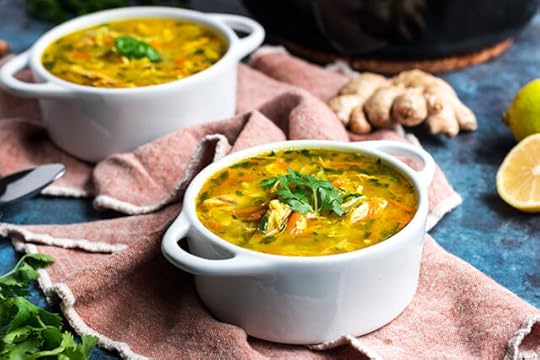
Your classic chicken noodle soup made Primal, paleo, and keto friendly with a low-carb noodle alternative. (No, it’s not zucchini.) The Instant Pot pressure cooker saves time and is ideal for times when you don’t want to tend a pot on the stovetop.
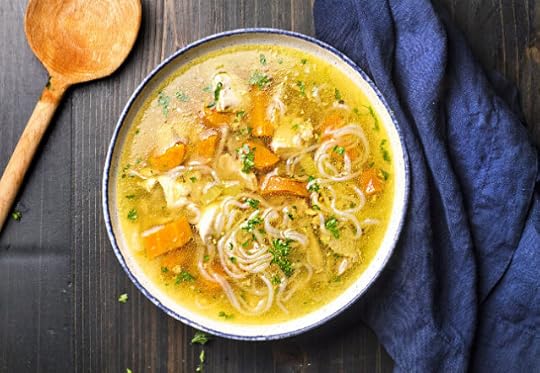
Bring the flavors of Italy and San Francisco together (yes, you read that right) in this tomato-y, garlicky masterpiece. It’s easier than you might think.

A powerhouse of healthy fats that combines some ingredients you might not have tried before—red palm oil and kohlrabi or rutabaga—with Primal favorites salmon and coconut milk. Try this soup next time you’re feeling stuck in a menu rut.

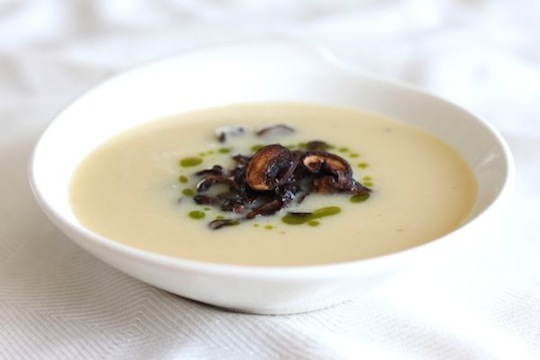
Get a hefty serving of sulfur-rich broccoli in this creamy soup that somehow manages to be both light and filling. The recipe is dairy-free, but feel free to add a little (or a lot of) shredded cheese to your bowl!
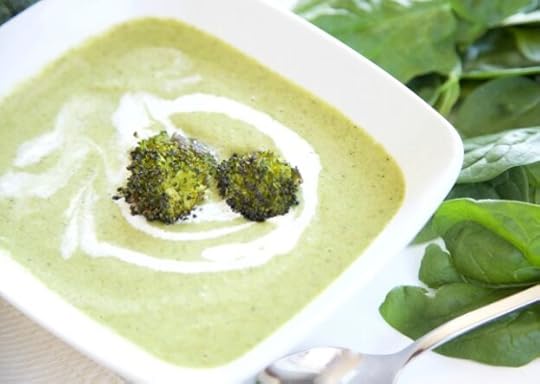
Most people ignore celeriac, or celery root, at the grocery store. We get it. It looks kind of like a dirty, hairy, misshapen potato—but looks are deceiving here. Celery root has a lovely delicate flavor that makes for an absolutely wonderful blended soup.

A fall classic, you can’t pass up butternut squash soup!
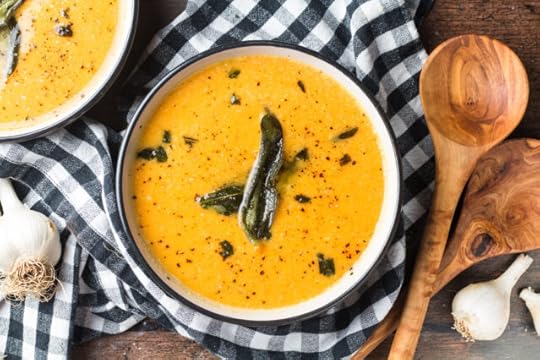
This tomato soup recipe features a unique time-saving ingredient. Shhh!
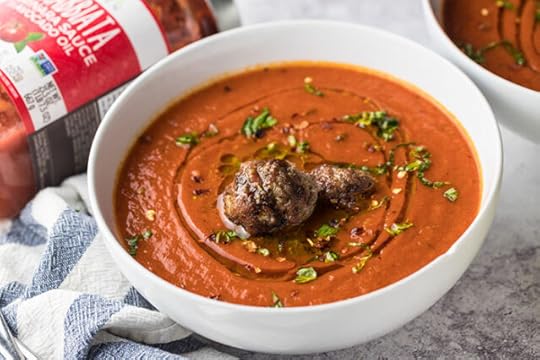
Here is another great option with immune-boosting ingredients. If you don’t care for lamb, substitute ground turkey instead.

Cabbage is abundant and affordable at farmer’s markets in the fall. If you’ve only had cabbage in coleslaw, try this recipe! When you slowly simmer it, the flavor changes considerably, becoming mild and lightly sweet.

Spicy and rich, this soup is like nothing else on this list. Try it with different types of kimchi to discover unique flavors.

Let us know in the comments which of these soups you’re going to make first!
(function($) { $("#dfl9fJm").load("https://www.marksdailyapple.com/wp-ad..." ); })( jQuery ); 
The post Fantastic Fall Soup Recipes appeared first on Mark's Daily Apple.
October 10, 2023
10 Animal Moves for Kids
 Animal moves are great way to “trick” your child into exercising, building strength, improving mobility, and getting a great workout. The key is that rather than force exercise kids can have fun walking like a duck or instead of doing box jumps they can do frog jumps.
Animal moves are great way to “trick” your child into exercising, building strength, improving mobility, and getting a great workout. The key is that rather than force exercise kids can have fun walking like a duck or instead of doing box jumps they can do frog jumps.
However, we are not quadrupeds or amphibians or water fowl—we are humans with completely different anatomies than the animals we mimic. Therefore our animal moves aren’t exactly the same as the animals who actually perform them. They might look even different if you’re an adult practicing animal movements for mobility and strength. For kids though, here are my ten favorite animal moves.
Duck WalkTo perform the duck walk, sit in a full squat with heels down and feet angling out 8 to 15%. While staying in the squat position, walk. One cue to maintain proper technique is to ensure your head doesn’t bob up and down. Aim to keep your head level as you duck walk. This is an excellent exercise for quad strength and hip mobility.
Bear CrawlA bear crawl is straightforward. Start on all fours and move on your hands and feet, keeping your back straight and parallel with the ground. Then, crawl contralaterally, which means moving your right arm with your left foot and your left arm with your right foot—opposite arm and leg moving together. As you become comfortable, try crawling forward, backward, to the right, and to the left. Challenge yourself further by crawling upstairs and downstairs or uphill both backward and forward. This movement is an ideal general warm-up for an exercise day as it gets your shoulders firing and engages your core. One thing to consider is doing five minutes of bear crawls a day around your house. Just accumulate five minutes daily, and you will feel more limber than you ever thought possible.
Bunny HopsSquat down on your heels and lightly place your hands on the floor in front of you for balance. Hop forward a foot or two without fully standing up, always maintaining that squatting position. Allow your hands to touch the floor, more as a reference point than as a base of support. Use this exercise to build strength in the squat’s bottom position.
Gorilla WalkBegin in a position similar to the bunny hop, but with feet slightly wider and more weight on the hands. To move in the gorilla walk, place most of the weight on your arms and catapult your lower body forward. Imagine being a silverback gorilla vaulting through the jungle on your massive knuckles.
Kangaroo HopThis is similar to the bunny hop, but there’s no arm involvement. It’s all about the quads and legs. Keep your torso more upright and hop along. You can also achieve a bit more hip extension on the jump, making it feel like more of a leap.
Backwards Snake CrawlLay down on your back and cross your arms. Move your hips and push off with your feet to crawl backward, pulling with your shoulder blades. This movement closely mimics a snake crawl. The key is to minimize limb use and rely mainly on your torso’s gyration.
Alligator CrawlFor the alligator crawl, start in a low plank position, as if you’re at the bottom of a push-up, with weight on your hands and toes. Keep your belly and chest just above the ground and crawl. Start slowly, then try speeding up as you get the hang of it. This crawl might be one of the most challenging ones and is excellent for building isometric arm, tricep strength, and core tension.
Frog JumpThe frog jump starts in a full squat. From there, jump as high and far as you can, landing back in a squat, then repeat. Ensure you maintain technical integrity; it’s not a race. Each jump should represent maximal output with perfect technique. If you begin to feel tired and notice sloppy technique, stop the exercise. This jump is excellent for peak power output. If you continue frog jumps into your 40s, 50s, or even older, you’ll be in a good position for long-term fitness.
Monkey Bars (Two Ways)There are a couple ways to do the monkey bars.
Bent arms: You can muscle your way across, keeping your arms flexed/bent as you pull yourself across from bar to bar. This is the fastest way to traverse the bars, but it’s also very hard on your arms. A great bicep workout.Straight arms: You can also swing with straight arms, using the momentum of your swinging legs and torso to carry you from bar to bar. This isn’t about arm strength, rather it’s predicated on being in rhythm and having a strong enough grip and stable shoulder girdle to support you going the distance.Crab WalkSit on the ground with your legs stretched out in front of you. From that position, place your hands and feet flat on the ground and lift yourself up so your body is no longer touching. Keeping your hips elevated, walk around forward, backward, and sideways. Always move contra laterally. Right hand, left foot. Left hand, right foot.
How to Use Animal MovesKids can use animal moves at any point in the day, but if you’re wondering when best to incorporate them take a look at the below suggestions:
A morning routine: Every morning, do 30 seconds to a minute of each of the animal moves. It’s a great way to start the day and get some movement going and blood flowing.Microworkouts: Every couple hours or so, do a minute or two of animal moves. Use them to break up sitting on the couch for extended amounts of time or better encourage them while kids are watching TV.Warmups: Animal moves are great for warming up before a more intense activity. If your kid plays soccer duck walks, alligator walks, and frog jumps. If they play a racket sport try bear crawls or straight arm monkey bars. The point of a warmup is to increase body temperature, elevate the heart rate, and mobilize the targeted muscles and joints. Animal moves are great for all that.Animal moves are a great way to have fun, build strength and mobility, and increase athleticism. Plus, they’re not just for kids, they’re great exercises for kids too. Thanks for reading, everyone. Take care.
(function($) { $("#dfWk7hp").load("https://www.marksdailyapple.com/wp-ad..." ); })( jQuery );
The post 10 Animal Moves for Kids appeared first on Mark's Daily Apple.
October 6, 2023
New and Noteworthy: What I Read This Week—Edition 240

Oldest human footprints in North America confirmed to be 23,000 years old.
If you have diabetes and low muscle mass, your risk of early death is 2 times greater than it should be.
Keto is better for migraines than a low-calorie “regular” diet.
More sleep variability, thicker carotid arteries.
South African prey animals fear humans more than lions.
New Primal Kitchen PodcastsPrimal Kitchen Podcast: So What’s Your Gut Telling You?
Primal Health Coach Radio: Marcus Farris
Media, Schmedia“Fat but fit” was never real.
A sixth basic flavor discovered—ammonium chloride.
Interesting Blog PostsThe interaction of muscle mass and strength with cognitive function.
Social NotesEverything ElseCancer has increased in adults younger than 50.
Statin side effects in patients with heart failure.
Things I’m Up to and Interested InOnce again: Linoleic acid linked to femur head necrosis.
Not surprised: Vegetarian men and women have a greater risk of hip fracture.
As I’ve said: There are no free lunches.
Important: Depressed teens with shorter telomeres have a greater risk of suicide.
Of course: Animal milk far more nutrient-dense than alternatives.
Question I’m AskingWhat meds are you taking?
Recipe CornerBaked apples. Easy dessert.. Noodles are optional, of course, or can be substituted with zucchini.Time CapsuleOne year ago (Sep 30 – Oct 6)
Cold Therapy Benefits—Why to do it.Keto Cauliflower Mac and Cheese—Great recipe.Comment of the Week
“Interesting New Yorker article on carnivory. One big problem with a carnivore diet is that it’s expensive. Obviously, it’s somewhat offset by the fact that one isn’t buying a lot of the other food people usually buy, but it’s still going to be quite costly.
The other problem is that for many of us, it’s unappetizing. I grew up eating a wide variety of vegetables, mostly grown in my dad’s garden. We also ate meat or fish with most meals, but we never ate meat, poultry or fish exclusively. I really like veggies and remain unconvinced that eliminating them is the long-range answer for me and my family. For that reason, I prefer to stick with a more paleo way of eating.“
-Good reason.
(function($) { $("#dfNi4LV").load("https://www.marksdailyapple.com/wp-ad..." ); })( jQuery ); 
The post New and Noteworthy: What I Read This Week—Edition 240 appeared first on Mark's Daily Apple.
September 29, 2023
New and Noteworthy: What I Read This Week—Edition 239

Mechanistic link between low zinc and diabetes.
No link between red or processed meat and pancreatic cancer.
Of the carbs, fruit and non-starchy vegetables are linked to the least weight gain; starch and sugar the most..
Exercise for depression works.
How LEDs affect nutrient levels in kale..
New Primal Kitchen PodcastsPrimal Kitchen Podcast: So What’s Your Gut Telling You?
Primal Health Coach Radio: Rebecca Tracey
Media, SchmediaThe New Yorker examines the carnivore movement.
Interesting Blog PostsA genocide you don’t hear much about.
Social NotesWhy you need to soak up as much sun as you can.
Everything ElseTakedown of the new Nordic Nutrition Recommendations.
Things I’m Up to and Interested InCool supplement to consider: Curcumin for blood glucose indices.
Not surprised: Most of the scientists on a recent panel recommending the consumption of ultra processed foods were employed by processed food companies.
As I’ve said: Lab grown meat is never going to take off.
Important: The scientist who thinks she knows why testosterone levels have fallen worldwide.
Nice results: Older dialysis patients respond well to cluster set strength training (aka rest pause training).
Question I’m AskingHow is your exercise changing as the weather changes?
Recipe CornerLemon garlic chicken.Basic sautéed mushrooms.Time CapsuleOne year ago (Sep 23 – Sep 29)
How to Manage Shift Work—How to do it.How to Work Out with a BOSU Exercise Ball—What to do.Comment of the Week
“‘Per the cat study-
my experience with my cat Shiva-
she is approaching 16 and can’t hunt anymore because the hair was irritating her esophagus, and she was throwing up all the time… she was getting weaker and weaker… i didn’t want to put her on meds so i bought some organic chicken livers… she gobbled them right down, then i gave her grasss-fed heart and chicken hearts, I’m going to try grass-fed kidneys this week… she is looking amazing! Her coat is now healthy and she is gaining weight… the vet has always told me she is the healthiest cat she’s ever seen, never fleas or worms, but she was an accomplished hunter, averaging about two gophers per day, which she could hunt, take to our lawn, and consume in totality in less than 5 mins… sometimes if I just looked away it was gone, not a hair left… when she lost this ability, she started to decline very quickly, the organ meets are regaining her strength and vitality daily, she is de-aging!!!!“
-Nice tale of a decidedly non-vegan cat.
(function($) { $("#dfOJtFA").load("https://www.marksdailyapple.com/wp-ad..." ); })( jQuery ); 
The post New and Noteworthy: What I Read This Week—Edition 239 appeared first on Mark's Daily Apple.
September 25, 2023
10 Spices You Should Be Using
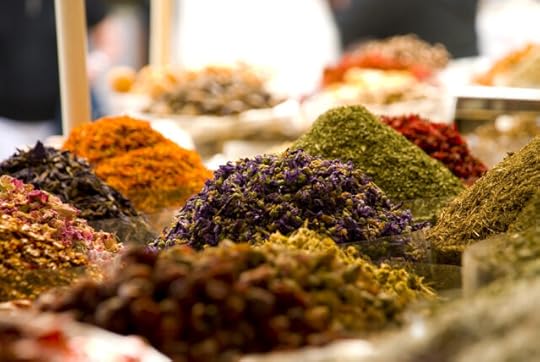
We typically think of spices as flavors. They make things taste spicy or zesty, add complexity, combine with other spices to form popular and traditional flavor profiles like “chili powder” or “garam masala,” and simply just make food taste really good. This is true, but they’re also much more. Similar to herbs, spices tend to be anti-inflammatory and anti-microbial out of self-preservation—when they’re growing on a plant, they don’t want fungus and bacteria and bugs to eat them and so they employ various compounds that deter and inhibit predators. We can leverage those compounds to enhance the health effects of food, make the cooking process safer, reduce the formation of carcinogens, and actually prevent spoilage.
Oh, and properly used spices make food taste great.
I’d say that using spices is the quintessential human activity. It’s a perfect example of taking something that’s “bad” on paper—antimicrobial compounds, anti nutrients that are meant to kill bugs and fungus—and using it for our own benefit. Let’s get down to the spices:
Black pepperBlack pepper isn’t just something that goes with salt. When freshly ground, it’s incredibly piquant and even spicy, and it has potent effects on lipid oxidation and carcinogen formation.
Black pepper extract reduces LDL oxidation in vitro.https://www.thieme-connect.com/produc... fed to pigs, black pepper raises HDL levels (“good cholesterol,” or at least a marker of good metabolic health).https://www.sciencedirect.com/science... added to beef patties before cooking, black pepper reduced the formation of heterocyclic amines (a potential carcinogen).https://pubmed.ncbi.nlm.nih.gov/32527...My favorite way to season steak is still salt and lots of black pepper. Nothing else is needed.
TurmericDespite its vibrant yellow color, turmeric is actually a rather mild spice. It’s a little spicy, a little bitter, and it certainly has a unique aroma, but by itself it just doesn’t taste like very much at all. It’s typically combined with other spices to make curry powder.
As a health supplement, it’s extremely powerful.
Turmeric appears to be effective against arthritis.https://pubmed.ncbi.nlm.nih.gov/27533... is effective against depression, often working better than common antidepressants with fewer side effects.[ref]https://pubmed.ncbi.nlm.nih.gov/33329109/">4When added to meat during or prior to cooking, turmeric reduces the formation of heterocyclic amines.https://pubmed.ncbi.nlm.nih.gov/34646...My favorite way to use turmeric is with black pepper. In fact, black pepper “activates” turmeric, making it far more effective in your body. Soft boiled eggs tossed in turmeric, black pepper, and salt is an excellent way to obtain the health benefits of turmeric without having to cook up an elaborate Indian curry.
CinnamonThere are two types of cinnamon. Ceylon, or true cinnamon, and cassia, which is what most “cinnamon” sold in the US actually is. Both taste like cinnamon and can be used in recipes interchangeably, but Ceylon is more complex, sweeter, and generally more subtle. I prefer Ceylon personally. It’s also worth noting that cassia has a decent amount of coumarin, which can thin the blood and harm the liver when eaten in excess. If you go with cassia cinnamon, don’t eat more than a teaspoon a day.
Ceylon is unique in that it contains a specific polyphenol that may have efficacy against Alzheimer’s.https://pubmed.ncbi.nlm.nih.gov/19433... appears better for lowering blood glucose levels, although Ceylon is also helpful here too.https://pubmed.ncbi.nlm.nih.gov/17140... in general can be very useful the morning after a bad night’s sleep by reducing the insulin resistance that normally accompanies poor sleep.https://pubmed.ncbi.nlm.nih.gov/19627...Cinnamon is an underrated spice for pork.
SaffronPerhaps the world’s most expensive spice by weight, saffron is derived from the dried stigmas of the Crocus sativus flower. It imparts a unique golden hue and a flavor that I can only describe as grassy and sweet.
Considering its health aspects:
Saffron is notable for its mood-enhancing properties. Studies have indicated its potential effectiveness against depressive symptoms, possibly on par with certain conventional antidepressants.https://pubmed.ncbi.nlm.nih.gov/24299... has shown efficacy in reducing waist circumference, lowering blood sugar, and improving sexual function.https://pubmed.ncbi.nlm.nih.gov/27723..., saffron might have potential benefits for vision. Certain compounds in saffron appear protective against age-related macular degeneration.https://pubmed.ncbi.nlm.nih.gov/35231...Use saffron sparingly in dishes like paella, biryani, or Persian rice. It’s also very nice in broth or chicken soup. You don’t need more than a small pinch to impart both color and flavor.
CuminCumin has a long and rich history of culinary and medicinal use. Its distinctively warm, slightly bitter, and earthy flavor can be traced back to ancient Egyptian tombs and the kitchens of ancient Rome and Greece and later into the New World.
Cumin lowers fat mass, waist circumference, fasting blood sugar and insulin, and improves host of other metabolic markers in overweight women.https://pubmed.ncbi.nlm.nih.gov/25456... seeds also possess antioxidant properties, which assist in neutralizing harmful free radicals in the body.https://pubmed.ncbi.nlm.nih.gov/25229... shows promise in reducing symptoms of irritable bowel syndrome, according to a recent case series.https://pubmed.ncbi.nlm.nih.gov/24829...While cumin is a cornerstone in many curry blends and chili powders, it’s great as a standalone spice. I highly recommend using whole cumin seeds, toasting them, and then grinding them for use in spice rubs on lamb or beef.
PaprikaThere are many varieties of paprika, but they all come from ground dried peppers. Some are hot, some are mild, some are sweet, and some are smoked. They all confer a brilliant red hue to the dish, a floral fragrance, and an enormous antioxidant profile.
Paprika is loaded with lutein and zeaxanthin, which may improve cognitive function and eye health.https://www.ncbi.nlm.nih.gov/pmc/arti... is known for its antioxidant-rich profile, reducing carcinogen formation during cooking.https://pubmed.ncbi.nlm.nih.gov/25589...I love putting paprika in almost everything. As I said before, there’s a paprika for every occasion. Smoked paprika can replicate the smokiness of great barbecue. Hot paprika can rival cayenne for sweet heat. Sweet paprika is fruity, tart, and bright, while mild paprika is very subtle but can contribute color and fragrance to a dish.
SumacIf you need something acidic, something citrusy, and you don’t have fresh lemon or lime juice and you’d rather not use vinegar, try sumac. It’s how the Romans added acid to their dishes before lemons made it to the Empire. As a nutraceutical, it shows some promise.
Sumac lowers blood sugar, fasting insulin levels, and insulin resistance, although the results need to be confirmed with further studies.https://pubmed.ncbi.nlm.nih.gov/34334... mg of sumac a day reduces diastolic blood pressure in overweight adults.https://pubmed.ncbi.nlm.nih.gov/37189... mg a day lowers fasting insulin, inflammatory markers, and improves liver fibrosis and liver enzymes in patients with non alcoholic fatty liver disease.https://pubmed.ncbi.nlm.nih.gov/33190...Most recipes involving sumac are African or Middle Eastern, but there’s no reason you can’t use it for any dish that needs acidity. It goes great in BBQ rubs, on lamb, or on chicken and fish.
CardamomCardamom is known for its intensely aromatic, even “sweet” flavor. There are two types: green and black. Green cardamom is lighter and more delicate, with a sweet, eucalyptus note. Black cardamom is more robust, with a smoky character.
It’s impressive as a nutraceutical:
Cardamom lowers triglycerides and improves liver antioxidant status.https://pubmed.ncbi.nlm.nih.gov/27888... has broad efficacy against metabolic syndrome.https://pubmed.ncbi.nlm.nih.gov/35317... evidence suggesting cardamom’s potential in helping lower blood pressure, particularly in individuals with elevated levels.https://pubmed.ncbi.nlm.nih.gov/20361...Cardamom typically appears in desserts of all kinds, but I also like adding a touch of it to chili. Gives it a real interesting flavor profile.
CorianderCoriander is the dried seed from the cilantro plant. The seeds provide a warm, nutty, slightly citrusy taste that works well in Mexican cooking, marinades, and broths but tastes almost nothing like cilantro the herb. It also provides some health effects:
Coriander seed powder reduces triglycerides and blood pressure in overweight patients.https://pubmed.ncbi.nlm.nih.gov/30150... seeds may also reduce lead-induced oxidative stress in the brain, at least in rats.https://pubmed.ncbi.nlm.nih.gov/24793... may even have efficacy against anxiety.https://pubmed.ncbi.nlm.nih.gov/22022...Any Mexican cooking involving beef almost requires coriander seed to make an appearance. If I’m marinating skirt or flap steak, I’m including coriander (along with garlic, lime juice, and cumin).
CayenneCayenne is a dried hot pepper. It’s known for its fiery heat, which is due to its high concentration of capsaicin. This bright red spice adds both zest and depth to dishes. The really good stuff also has some sweetness. As for the health effects:
Cayenne is a bit of a “broad spectrum” nutraceutical, positively affecting almost everything you can imagine.https://pubmed.ncbi.nlm.nih.gov/33337... cayenne may even enhance wound healing.https://pubmed.ncbi.nlm.nih.gov/37387... added to meat before/during cooking, cayenne inhibits the formation of carcinogens.https://pubmed.ncbi.nlm.nih.gov/27979...Cayenne’s unique heat profile makes it a perfect addition to spicy dishes. It’s not so hot that it overwhelms the flavor, but it’s potent enough to taste even just a sprinkle. I really like finishing a dish with a dusting of cayenne.
No single spice does everything. Rather than choose your spices based on the potential health benefits, choose spices that will make the food you’re cooking taste great, and trust that the benefits will emerge on their own. If there’s one lesson to learn, it’s that every culinary spice also has nutritional applications and effects.
What are your favorite spices, folks? How do you like to use them?
(function($) { $("#df5NrL3").load("https://www.marksdailyapple.com/wp-ad..." ); })( jQuery ); References https://www.thieme-connect.com/products/ejournals/abstract/10.1055/s-0029-1234725https://www.sciencedirect.com/science/article/pii/S2590262819300048https://pubmed.ncbi.nlm.nih.gov/32527489/https://pubmed.ncbi.nlm.nih.gov/27533649/[ref/]Turmeric is effective against depression, often working better than common antidepressants with fewer side effects.[ref]https://pubmed.ncbi.nlm.nih.gov/33329109/https://pubmed.ncbi.nlm.nih.gov/34646527/https://pubmed.ncbi.nlm.nih.gov/19433898/https://pubmed.ncbi.nlm.nih.gov/17140783/https://pubmed.ncbi.nlm.nih.gov/19627193/https://pubmed.ncbi.nlm.nih.gov/24299602/https://pubmed.ncbi.nlm.nih.gov/27723543/https://pubmed.ncbi.nlm.nih.gov/35231199/https://pubmed.ncbi.nlm.nih.gov/25456022/https://pubmed.ncbi.nlm.nih.gov/25229184/https://pubmed.ncbi.nlm.nih.gov/24829694/https://www.ncbi.nlm.nih.gov/pmc/articles/PMC3693724/https://pubmed.ncbi.nlm.nih.gov/25589062/https://pubmed.ncbi.nlm.nih.gov/34334274/https://pubmed.ncbi.nlm.nih.gov/37189189/https://pubmed.ncbi.nlm.nih.gov/33190008/https://pubmed.ncbi.nlm.nih.gov/27888503/https://pubmed.ncbi.nlm.nih.gov/35317114/https://pubmed.ncbi.nlm.nih.gov/20361714/https://pubmed.ncbi.nlm.nih.gov/30150192/https://pubmed.ncbi.nlm.nih.gov/24793421/https://pubmed.ncbi.nlm.nih.gov/22022003/https://pubmed.ncbi.nlm.nih.gov/33337034/https://pubmed.ncbi.nlm.nih.gov/37387413/https://pubmed.ncbi.nlm.nih.gov/27979221/
References https://www.thieme-connect.com/products/ejournals/abstract/10.1055/s-0029-1234725https://www.sciencedirect.com/science/article/pii/S2590262819300048https://pubmed.ncbi.nlm.nih.gov/32527489/https://pubmed.ncbi.nlm.nih.gov/27533649/[ref/]Turmeric is effective against depression, often working better than common antidepressants with fewer side effects.[ref]https://pubmed.ncbi.nlm.nih.gov/33329109/https://pubmed.ncbi.nlm.nih.gov/34646527/https://pubmed.ncbi.nlm.nih.gov/19433898/https://pubmed.ncbi.nlm.nih.gov/17140783/https://pubmed.ncbi.nlm.nih.gov/19627193/https://pubmed.ncbi.nlm.nih.gov/24299602/https://pubmed.ncbi.nlm.nih.gov/27723543/https://pubmed.ncbi.nlm.nih.gov/35231199/https://pubmed.ncbi.nlm.nih.gov/25456022/https://pubmed.ncbi.nlm.nih.gov/25229184/https://pubmed.ncbi.nlm.nih.gov/24829694/https://www.ncbi.nlm.nih.gov/pmc/articles/PMC3693724/https://pubmed.ncbi.nlm.nih.gov/25589062/https://pubmed.ncbi.nlm.nih.gov/34334274/https://pubmed.ncbi.nlm.nih.gov/37189189/https://pubmed.ncbi.nlm.nih.gov/33190008/https://pubmed.ncbi.nlm.nih.gov/27888503/https://pubmed.ncbi.nlm.nih.gov/35317114/https://pubmed.ncbi.nlm.nih.gov/20361714/https://pubmed.ncbi.nlm.nih.gov/30150192/https://pubmed.ncbi.nlm.nih.gov/24793421/https://pubmed.ncbi.nlm.nih.gov/22022003/https://pubmed.ncbi.nlm.nih.gov/33337034/https://pubmed.ncbi.nlm.nih.gov/37387413/https://pubmed.ncbi.nlm.nih.gov/27979221/The post 10 Spices You Should Be Using appeared first on Mark's Daily Apple.
September 15, 2023
New and Noteworthy: What I Read This Week—Edition 238

Both short and longer naps help restore blood pressure function in shift workers.
For optimal seminal health, including fertility, testosterone, and sperm volume, aim to have high HDL and low triglycerides.
Tea appears especially helpful for circadian health.
A little passive stretching is good for older men.
High-load strength training tends to be more effective than blood flow restricted strength training, but the latter can be comparable if applied properly.
New Primal Kitchen PodcastsPrimal Kitchen Podcast: The Secrets of High Performers with Psychotherapist and Triathlete, David Roadhouse
Primal Health Coach Radio: Laurie Olivier
Media, SchmediaIs a volcano responsible for much of 2023’s heat?
Interesting Blog PostsReminder: we are designed to eat meat.
Social NotesHow I work out when I don’t have much time.
Everything ElseTesting artificial wombs to support premature babies may begin soon.
Things I’m Up to and Interested InCool supplement to consider: Nattokinase for managing atherosclerosis.
Interesting: Using the Fast and the Furious soundtrack to trigger insulin secretion in human cells.
Consistent finding: Problems arise when a population strays from their traditional diet.
Milk differences: Vegan mothers produce milk with more selenium, less iodine and iron than omnivorous mothers.
Keep busy: More hobbies, less depression.
Question I’m AskingHow do you exercise when you’re short on time?
Recipe CornerSheet pan Italian chicken.Braised apricot and cranberry brisket. You might reduce some of the sugar, and definitely swap out the canola oil for avocado oil.Time CapsuleOne year ago (Sep 9 – Sep 15)
Primal Skincare: Best Practices for Healthy Skin—How to get and keep good skin.A Guide to Choosing Sustainable Fabrics—What to wear and why.Comment of the Week
“‘What’s your “elevator spiel” for better health?
No idea; I take the stairs.“
-Touché.
(function($) { $("#df81O6f").load("https://www.marksdailyapple.com/wp-ad..." ); })( jQuery ); 
The post New and Noteworthy: What I Read This Week—Edition 238 appeared first on Mark's Daily Apple.
September 8, 2023
New and Noteworthy: What I Read This Week—Edition 237

Heart disease rate and mortality rate were higher in people with no “risk factors” than in people with only the “risk factor” of high LDL-C.
Cellulose-based emulsifiers and heart disease.
Monkey mothers who ate a standard American diet during pregnancy give birth to babies with altered gene expression and elevated insulin secretion.
Older first-time moms are at a higher risk for breast cancer.
New Primal Kitchen PodcastsPrimal Kitchen Podcast: The Link Between Strength and Success with Endurance Athlete Eric Hinman
Primal Health Coach Radio: Q&A with Erin Power
Media, SchmediaLab meat company fails to pay invoices.
Interesting Blog PostsSocial NotesEverything ElseHumans faced a huge population bottleneck in the ancient world.
Slaughtering the buffalo had lasting impacts on the people who relied on them.
Things I’m Up to and Interested InInteresting video: Fauci addresses Cochrane study that said masks don’t really work.
Delicious: The USDA wants you eating ultra processed blends of beans, grains, and vegetables.
Interesting report: On climate metrics for livestock.
But why?: Early onset cancer on the rise.
Classic paper: A hunter-gatherer health prescription.
Question I’m AskingWhat’s your “elevator spiel” for better health?
Recipe CornerSheet pan cashew chicken.Tomahawk steak.Time CapsuleOne year ago (Sep 2 – Sep 8)
How to Eat Healthy in College—How to.Ask a Health Coach: Foods to Help With Stress and Anxiety—What helps?Comment of the Week
“‘Mark, your observations about not taking chances are spot on. I wish I’d learned much earlier in life the benefits of getting outside my comfort zone. Anthony Bourdain, the renowned chef and life observer was quoted as saying, “Embrace fear; know your strength; live with purpose.” Words to live a fuller life by.“
-Absolutely, Steve.
(function($) { $("#dfviYly").load("https://www.marksdailyapple.com/wp-ad..." ); })( jQuery ); 
The post New and Noteworthy: What I Read This Week—Edition 237 appeared first on Mark's Daily Apple.
September 1, 2023
New and Noteworthy: What I Read This Week—Edition 236

Predictions of drug free type 2 diabetes remission.
Low-carb wins (again) in type 2 diabetes.
Are 12% of the population responsible for 50% of the beef consumption?
Acrolein triggers insulin resistance.
Seasonal allergies and accidents.
New Primal Kitchen PodcastsPrimal Kitchen Podcast: Chef and Entrepreneur Camilla Marcus Champions Great Taste with Less Waste
Primal Health Coach Radio: Michelle Leotta
Media, SchmediaDrug use among adults reaches all-time high.
Interesting Blog PostsA cautionary take on sweeteners.
Early use of carnivore for diabetes.
Social NotesEverything ElseToo much safety is dangerous and boring.
Prehistoric bird returns to New Zealand.
What increases morale?
Things I’m Up to and Interested InInteresting: Can evolution be reversed?
Great video: Common lies about keto.
Reminder: Keep marijuana edibles away from kids.
Once again: We know very little about the microbiome.
Do you agree?: Men who are frequent social media posters are seen as less manly.
Question I’m AskingWhat prehistoric animal would you like to come back?
Recipe CornerSheet pan eggs.Sashimi de atún.Time CapsuleOne year ago (Aug 26 – Sep 1)
What is the Protein-Sparing Modified Fast Diet?—What is it?6 Functional Exercises to Improve Balance and Stability—Stop falling.Comment of the Week
“‘Icing promotes muscle regeneration after light injury.’
Ohhh, you mean applying ice.
Sigh.
Burst my dream.“
-Ha, sorry to disappoint.
(function($) { $("#dfHRic2").load("https://www.marksdailyapple.com/wp-ad..." ); })( jQuery ); 
The post New and Noteworthy: What I Read This Week—Edition 236 appeared first on Mark's Daily Apple.
Mark Sisson's Blog
- Mark Sisson's profile
- 199 followers



